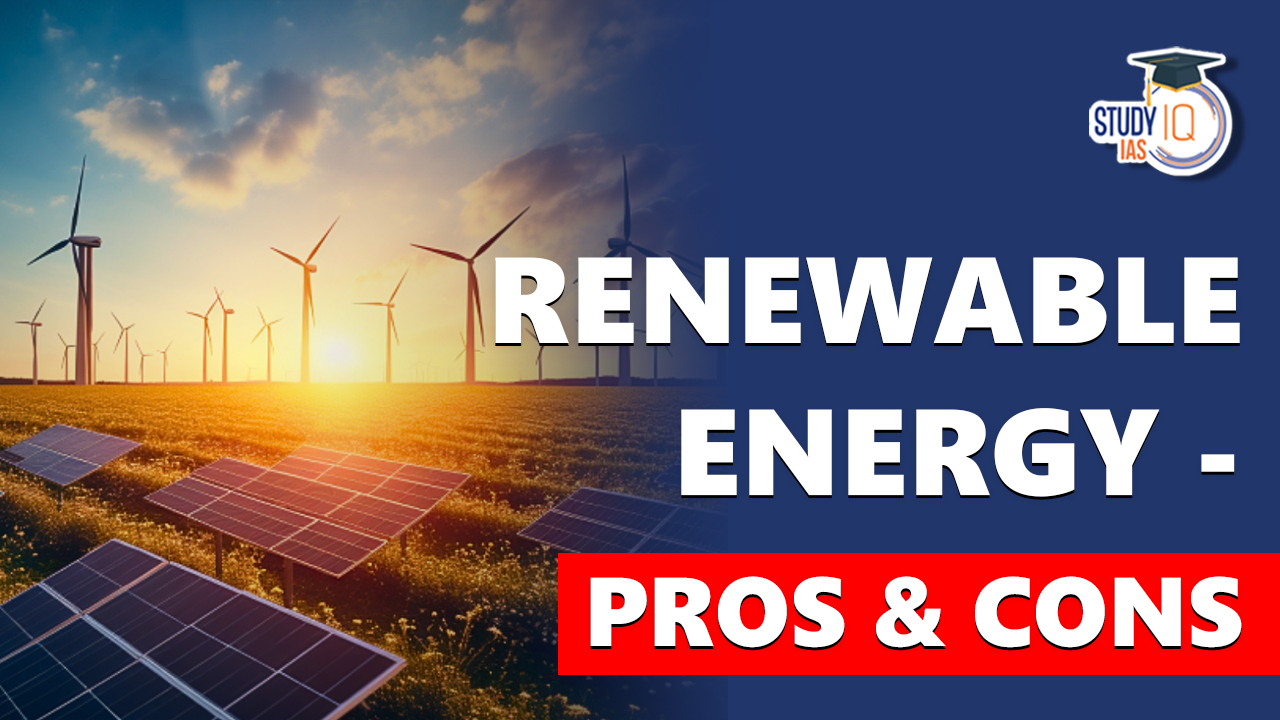|
India’s Potential and Efforts for Renewable Energies
|
| Solar Energy |
Pros:
- Renewable and low carbon: Inexhaustible source of energy and is environment friendly.
- Cost-savings: Once installed, solar panels offer long-term cost savings, especially as the cost of solar panels continues to decline.
- Low maintenance: Solar panels require minimal maintenance since there are no moving parts.
Cons:
- High initial costs: The initial installation cost of solar panels can be relatively high, including the cost of solar panels, inverters, mounting systems, and installation labor.
- Intermittency: Energy production is limited during cloudy days or at night unless energy storage systems or backup power sources are utilized.
- Space requirements: Generating significant amounts of solar power requires a considerable amount of space for installing solar panels.
- Geographic Limitations: The effectiveness of solar energy can vary depending on geographic location and local climate conditions.
India’s Potential:
- India is endowed with vast solar energy potential. India receives nearly 3000 hours of sunshine every year.
- About 5,000 trillion kWh per year of energy is incident over India’s land area with most parts receiving 4-7 kWh per sq. m per day.
- National Institute of Solar Energy has assessed India’s solar potential to be about 750 GW assuming 3% of the waste land area to be covered by Solar PV modules.
Government initiatives:
- National Solar Mission: It is a major initiative to promote ecologically sustainable growth while addressing India’s energy security challenge.
- SRISTI Scheme: Sustainable rooftop implementation of Solar transfiguration of India (SRISTI) scheme to promote rooftop solar power projects in India.
- Solar Park Scheme: The Solar Park Scheme plans to build a number of solar parks, each with a capacity of nearly 500 MW, across several states.
- Rooftop Solar Scheme: It aims to harness solar power by installing solar panels on the roof of houses.
- PM KUSUM: The scheme aims to add solar and other renewable capacity of 30,800 MW by 2022 with total central financial support of Rs. 34,422 Crores.
- Atal Jyoti Yojana (AJAY): The AJAY scheme was launched in September 2016 for the installation of solar street lighting (SSL) systems in states with less than 50% of households covered with grid power (as per Census 2011).
- International Solar Alliance: It is an action-oriented, member-driven, collaborative platform for increased deployment of solar energy technologies.
|
| Wind energy |
Types of Wind Farm/Parks:
- Offshore: offshore turbines are located out at sea or in freshwater.
- Onshore: Onshore wind refers to wind turbines located on land.
Pros of Offshore Wind:
- Windmills can be built that are larger and taller than their onshore counterparts, allowing for more energy collection.
- They tend to be far out at sea, meaning they are much less intrusive to neighbouring countries, allowing for larger farms to be created per square mile.
- Typically, out at sea, there is a much higher wind speed/force allowing for more energy to be generated at a time.
- There are no physical restrictions such as hills or buildings that could block the wind flow.
Cons of Offshore Wind:
- The biggest disadvantage of an offshore wind farm is the cost. Offshore wind farms can be expensive to build and maintain and because of their hard-to-reach locations, they are susceptible to damage from very high-speed winds during storms or hurricanes which is expensive to repair.
- The effect of offshore wind farms on marine life and birds are not yet fully understood.
- Offshore wind farms that are built closer to coastlines (generally within 26 miles) can be unpopular with residents as it can affect property values and tourism.
Pros of Onshore Wind:
- The cost of onshore wind farms is relatively cheap, allowing for mass farms of wind turbines.
- The shorter distance between the windmill and the consumer allows for less voltage drop off on the cabling.
Cons of onshore Wind:
- One of the biggest issues of onshore wind farms is that many deem them to be an eyesore on the landscape.
- They don’t produce energy all year round due to often poor wind speed or physical blockages such as buildings or hills.
- The noise that wind turbines create noise pollution for nearby communities.
India’s Potential
- India is blessed with a coastline of about 7600 km surrounded by water on three sides and has good prospects of harnessing offshore wind energy.
- The recent assessment indicates a gross wind power potential of 302 GW in the country at 100 meters and 695.50 GW at 120 meters above ground level.
Government Initiatives
- National Wind-Solar Hybrid Policy: The main objective is to provide a framework for promotion of large grid connected wind-solar PV hybrid systems for optimal and efficient utilization of wind and solar resources, transmission infrastructure and land.
- National Offshore Wind Energy Policy: Notified in October 2015 with an objective to develop the offshore wind energy in the Indian Exclusive Economic Zone (EEZ) along the Indian coastline of 7600 km.
|
| Hydro Power |
About Hydro Power:
- Hydro power can be captured when water flows downward from a higher level to a lower level which is then used to turn the turbine.
- Hydro power projects are generally categorized in two segments i.e., small and large hydro.
- In India, hydro projects up to 25 MW station capacities have been categorized as Small Hydro Power (SHP) projects.
- While Ministry of Power, Government of India is responsible for large hydro projects, the mandate for the subject small hydro power (up to 25 MW) is given to Ministry of New and Renewable Energy.
Pros:
- Hydropower is a renewable source of energy because it uses and not consumes the water for generation of electricity.
- It is a renewable source of energy with no consumables involved; there is very little recurring cost and hence no high long-term expenditure.
- It is cheaper as compared to electricity generated from coal and gas fired plants.
- Hydropower stations are preferred solution for meeting peak loads in grids due to its unique capabilities of quick starting and closing.
- The operational needs of hydro & thermal stations are complimentary, and the balanced mix helps in optimal utilization of the capacity.
Cons:
- The hydropower generation is highly capital-intensive mode of electricity generation.
- Since hydropower projects are primarily located in hilly areas, where forest cover is comparatively better than plain areas, diversion of forest land is sometimes unavoidable.
- Submergence of land, thereby loss of flora and fauna and large-scale displacement, due to the hydropower projects.
- Dams can only be built at specific locations.
India’s Potential:
- India’s hydroelectric power potential is estimated at 148,700 MW at a 60% load factor. An additional 6,780 MW from smaller hydro schemes (with capacities of less than 25 MW) is estimated as exploitable.
- Hydropower potential is located mainly in northern and north-eastern regions.
- Arunachal Pradesh has the largest unexploited hydropower potential of 47 GW, followed by Uttarakhand with 12 GW.
- Unexploited potential is mainly along three river systems – the Indus, Ganges and Brahmaputra.
Government Initiatives:
- The Government had taken several policy initiatives in the past for hydropower development in the country viz., National Electricity Policy 2005, National Tariff Policy 2016, National Rehabilitation & Resettlement Policy 2007 and Right to Fair Compensation & Transparency in Land Acquisition, Rehabilitation and Resettlement Act 2013.
- Small Hydro Power Programme: The objective is to encourage the State Government entities and Independent Private Producers (IPPs) to set up new Small Hydro projects.
|
| Biomass Energy |
- Biomass is renewable organic material that comes from plants and animals. Biomass energy is energy generated or produced by living or once-living organisms.
Pros
- Versatile: Biomass energy can have different uses ranging from cooking gas to generation of power with minimum effect on the environment.
- Renewable: It is a renewable source of energy and can be provided by nature in abundance.
- No net CO2 emissions (ideally): The emission of CO2 far too less in Biomass energy than other conventional sources of energies.
- Emits less SO2 and NOx than fossil fuels: The sulphur and nitrogen pollutants are minimal in biomass consumption.
Cons
- Low energy density/yield: Some biofuels, like Ethanol, is relatively inefficient as compared to gasoline.
- Land conversion: Land needed to produce biomass may compromise land for agriculture consequently impacting both food production and biodiversity.
India’s Potential
- As per a recent study sponsored by MNRE, the current availability of biomass in India is estimated at about 750 million metric tonnes per year.
- The Study indicated estimated surplus biomass availability at about 230 million metric tones per annum covering agricultural residues corresponding to a potential of about 28 GW.
- This apart, about 14 GW additional power could be generated through bagasse-based cogeneration in the country’s 550 Sugar mills.
Government Initiatives
- National Bioenergy Programme: Initiated in 2022, it has following sub-schemes:
- Waste to Energy (WTE) Programme: to support setting up of large Biogas, BioCNG and Power plants (excluding MSW to Power projects).
- Biomass Programme: to support setting up of pellets and briquettes for use in power generation and non-bagasse-based power generation projects.
- Biogas Programme: to support setting up of family and medium size Biogas in rural areas.
- National Policy on Biofuels: The policy is aimed at taking forward the indicative target of achieving 20% blending of biofuels with fossil-based fuels by 2025.
- Policy for biomass and bagasse cogeneration: It includes financial incentives and subsidies, both for biomass projects and sugar mills that use this technology.
|
| Geothermal Energy |
About Geothermal Energy:
- Geothermal energy is natural heat from the interior of the earth that can be used to generate electricity as well as to heat up buildings.
Pros:
- Renewable: It is believed that enough heat is radiated from the center of the earth to fulfill human energy demand for all the times to come.
- Easy to exploit in some cases: Since ancient times, people having been using this source of energy for taking baths, heating homes, preparing food etc.
- CO2 production less than with fossil fuel: It does not create any pollution and helps in creating a clean environment.
- High net energy yield: The cost of electricity production is almost competitive with conventional energy sources.
Cons:
- Not available everywhere: Geothermal hot spots are scattered and are at far away regions than the areas that need energy.
- H2S pollution: Large quantities of H2S “The rotten eggs” gas can be released and inhaling it in too many quantities is fatal.
- Geothermal energy harnessing produces some water pollution (somewhat similar to mining).
India’s Potential:
- Geological Survey of India has found around 350 geothermal energy locations in the country. The most promising of these is in the Puga valley of Ladakh.
- Geothermal resources in India have been mapped by GSI and a broad estimate suggests that there could be 10 gigawatts (GW) geothermal power potential, as per the Ministry of New and Renewable Energy (MNRE).
- India has 7 geothermal provinces [viz. Himalayas, Sohana, West Coast, Cambay (Gujarat), Godavari, Mahanadi and Son-Narmada-Tapi (SONATA)] and a number of geothermal springs.
Government Initiatives:
- First Geothermal power plant to come in Chhattisgarh by joint cooperation of NTPC and Chhattisgarh Renewable Energy Development Agency (CREDA). Tattapani geothermal field in SONATA geothermal province.
- MNRE provides large incentives and subsidies for Research, Design, Development and Demonstration (RDD&D) for harnessing geothermal energy in India.
|
| Tidal Energy |
About Tidal Energy:
- It is a form of renewable energy that harnesses the kinetic energy from the rise and fall of ocean tides.
- It converts the energy of tidal currents into usable electricity.
Pros:
- Predictable and Reliable: Unlike wind, ocean energy sources are more predictable. The endless flows create a reliable supply source for future availability.
- Energy-rich: Moving water is more than 800 times denser than moving air, which multiplies the kinetic energy by the same factor and opens up the scope of huge amounts of energy.
- Unlimited usage area: Land is a scarce resource, but ocean energies are provided by the vast and deep oceans.
Cons
- Deployment is currently limited in our country and already deployed technologies are under utilized.
- Either there is not much research done on the technologies or most are currently at the initial stage of R&D, demonstration and commercialization.
- Uncertainty of the marine environment and commercial scale risks like- corrosion of materials due to the salinity of seawater, offshore maintenance difficulties, the environmental impact on landscapes and the marine ecosystem and competition from other marine activities such as fishing.
India’s Potential
- Total identified potential of Tidal Energy is about 12455 MW, with potential locations identified at Khambat & Kutch regions, and large backwaters, where barrage technology could be used.
- The total theoretical potential of wave energy is estimated to be about 40,000 MW. This energy is however less intensive than what is available in more northern and southern latitudes.
|


 Cheetah Project Steering Committee Key R...
Cheetah Project Steering Committee Key R...
 World Heritage Day 2025, Theme, Objectiv...
World Heritage Day 2025, Theme, Objectiv...
 Alfalfa Flowering Plant, Benefits and Nu...
Alfalfa Flowering Plant, Benefits and Nu...





















